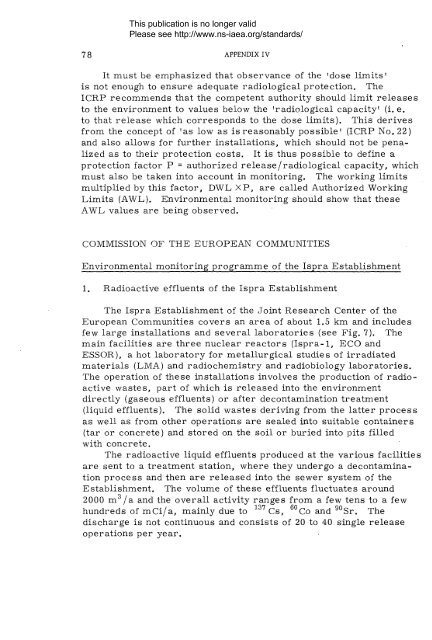Safety_Series_041_1975 - gnssn - International Atomic Energy ...
Safety_Series_041_1975 - gnssn - International Atomic Energy ...
Safety_Series_041_1975 - gnssn - International Atomic Energy ...
You also want an ePaper? Increase the reach of your titles
YUMPU automatically turns print PDFs into web optimized ePapers that Google loves.
This publication is no longer valid<br />
Please see http://www.ns-iaea.org/standards/<br />
7 8 APPENDIX IV<br />
It must be emphasized that observance of the 'dose limits'<br />
is not enough to ensure adequate radiological protection. The<br />
ICRP recommends that the competent authority should limit releases<br />
to the environment to values below the 'radiological capacity' (i. e.<br />
to that release which corresponds to the dose limits). This derives<br />
from the concept of 'as low as is reasonably possible' (ICRP No. 22)<br />
and also allows for further installations, which should not be penalized<br />
as to their protection costs. It is thus possible to define a<br />
protection factor P = authorized release/radiological capacity, which<br />
must also be taken into account in monitoring. The working limits<br />
multiplied by this factor, DWL XP, are called Authorized Working<br />
Limits (AWL). Environmental monitoring should show that these<br />
AWL values are being observed.<br />
COMMISSION OF THE EUROPEAN COMMUNITIES<br />
Environmental monitoring programme of the Ispra Establishment<br />
1. Radioactive effluents of the Ispra Establishment<br />
The Ispra Establishment of the Joint Research Center of the<br />
European Communities covers an area of about 1.5 km and includes<br />
few large installations and several laboratories (see Fig. 7). The<br />
main facilities are three nuclear reactors (Ispra-1, ECO and<br />
ESSOR), a hot laboratory for metallurgical studies of irradiated<br />
materials (LMA) and radiochemistry and radiobiology laboratories.<br />
The operation of these installations involves the production of radioactive<br />
wastes, part of which is released into the environment<br />
directly (gaseous effluents) or after decontamination treatment<br />
(liquid effluents). The solid wastes deriving from the latter process<br />
as well as from other operations are sealed into suitable containers<br />
(tar or concrete) and stored on the soil or buried into pits filled<br />
with concrete.<br />
The radioactive liquid effluents produced at the various facilities<br />
are sent to a treatment station, where they undergo a decontamination<br />
process and then are released into the sewer system of the<br />
Establishment. The volume of these effluents fluctuates around<br />
2000 m3/a and the overall activity ranges from a few tens to a few<br />
hundreds of mCi/a, mainly due to 137 Cs, 60Co and 90Sr. The<br />
discharge is not continuous and consists of 20 to 40 single release<br />
operations per year.

















